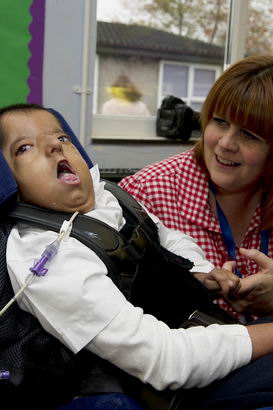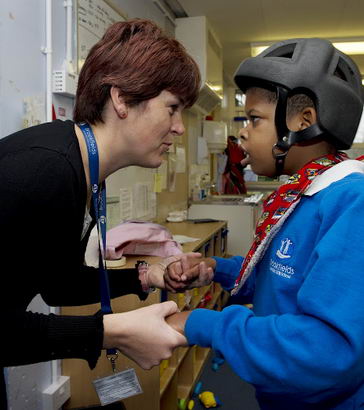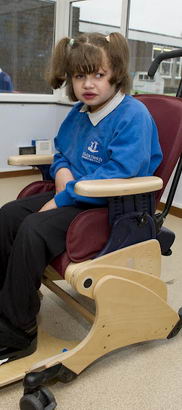
Some children develop differently and do not follow the expected pattern of development. Delayed or atypical development is recognised by comparing with typical milestones.
- Typical (or 'normal') development;
- Delayed development – follows the typical pattern, but at a much slower pace (the developmental milestones will be reached in the right order, but later than most children);
- Atypical/disordered development – the usual sequence of milestones is not followed, there is something different about the way the child develops;
- Borderline development – between typical and atypical.

Developmental conditions arise from a number
of causes:
- Genetic differences (eg Down's syndrome, Williams syndrome, Fragile X syndrome);
- Behavioural impairments (with possible genetic involvement) (eg autism, Specific Language Impairment, Attention Deficit/Hyperactivity Disorder (ADHD), dyslexia);
- Atypical environments (eg pollution, trauma, disease, maternal alcohol/substance abuse, deprivation or abuse);
- Unknown cause.
(Westermann et al, 2010)
The social model of disability is an essential daily living perspective. However, diagnosis of disability is valuable, at best leading to integrated early intervention, allowing parents and professionals to:
- Predict likely developmental pathways;
- Identify other likely educational/health/social needs associated with the disability;
- Increase vigilance in at-risk areas;
- Identify the most appropriate interventions;
- Plan ahead for likely future needs;
- Raise family awareness about genetic conditions;
- Dispel the sense of self-blame felt by many parents for their child's disability.
(Howard, 2007 and Whiting, 2007)
The following sections give a brief overview of the four major developmental areas – motor, communication, socio-emotional and cognition – in relation to a focus disability aligned with a developmental issue.
The focus disabilities were chosen as they are conditions which commonly co-exist in children with CLDD.
You can find out more about the following types of disabilities on the Specialist Schools and Academies Trust: CLDD briefing packs:
- Attachment disorders;
- Attention deficit hyperactivity disorders;
- Autism and autistic spectrum disorders;
- Foetal Alcohol Syndrome (FAS) disorder;
- Fragile X syndrome;
- Mental health;
- Prematurity;
- Rare chromosome disorders; and
- Sensory impairments.
The Royal National Institute of Blind People (RNIB) and the National Deaf Children's Society (NDCS) have useful resources for families and professionals who support children with SLD/PMLD/CLDD and a sensory impairment.
This section is for teaching professionals who work with children who have a visual impairment and additional learning, physical or sensory needs.
Find out more in the complex needs section of RNIB's website.
The NDCS also contains a number of resources and events that are suitable for parents of deaf children with additional needs.
You might also wish to read the following Manchester University report: Complex Needs, Complex Challenges.

Every 30 minutes, a child will acquire a brain injury. This could be the result of an accident, an illness
such as meningitis or encephalitis, a poisoning, a stroke or a brain tumour. A brain injury has a devastating and life-long
impact on the child and their whole family.
The Child Brain Injury Trust, undated
Support and information about these conditions is available from:
Identifying children's support needs early is vital if they are to thrive, and enables parents and professionals
to put the right approach in place quickly... Through effective early identification and intervention – working with
parents and families – we can reduce the impact that SEN or disability
may have...
Department for Education, 2011
Early intervention for children with SLD/PMLD/CLDD and their families lessens developmental impact, reduces secondary disabilities and enables families to function (Carpenter, 2005). For some disabilities (eg sensory impairments, metabolic conditions), the timing of early intervention is critical and urgent.
Early Support provides excellent family resources and guidance. Take a look at the Early Support materials and resources section of the Department for Education's website.

Carpenter, B. (2005) Real prospects for early childhood intervention: family aspirations and professional implications, in: B. Carpenter and J. Egerton (eds) Early Childhood Intervention: International perspectives, national initiatives and regional practice, Coventry: West Midlands SEN Regional Partnership.
Department for Education (2011) Support and Aspiration: A new approach to special educational needs and disability, Norwich: The Stationery Office. [accessed: 12.1.12].
Goswami, U. (2008) Learning Difficulties: Future challenges, Mental Capital and Wellbeing Project, London: Government Office for Science.
Howard, D. (2007) Child development and developmental problems, in: Levene, M.A. (ed.) MRCPCH Master Course, Oxford: Churchill Livingstone.

Slater, A., Hocking, I. and Loose, J. (2003) Theories and issues in child development, in: Slater, A. and Bremner, J.G. (eds) An Introduction to Developmental Psychology, Oxford: Blackwell.
Thelen, E. and Smith, L.B. (2006) Dynamic systems theory, in: Damon, W.D. and Lerner, R.M. (eds) Handbook of Child Psychology (vol. 1): Theoretical models of human development (6th edition), New York: John Wiley.
Westermann, G., Thomas, M.S.C. and Karmiloff-Smith, A. (2010) 'Neuroconstructivism'. In: U.Goswami (ed.) The Handbook of Cognitive Development (2nd edition). Oxford: Blackwell.
Whiting, K. (2001) Investigating the child with learning difficulty, Current Paediatrics, 11, 240-247 [accessed: 12.1.12].

Informative online factsheets are also available from a wide range of UK charities. The two organisations below are a good
place
to start.
Visit the Contact a Family website to find out more about a wide range of conditions.
Visit the PMLD Network's website.